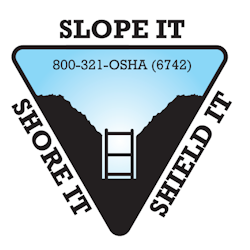Applying OSHA Standard
The Standards
29 CFR 1926.650, 29 CFR 1926.651, and 29 CFR 1926.652 are applicable OSHA standards.

The standard also provides several appendices:
- Appendix A, Soil Classification
- Appendix B, Sloping and Benching
- Appendix C, Timber Shoring for Trenches
- Appendix D, Aluminum Hydraulic Shoring for Trenches
- Appendix E, Alternatives to Timber Shoring and
- Appendix F, Selection of Protective Systems
The Basic Strategies
OSHA has made reducing trenching and excavation hazards the Agency's Priority Goal. Trench collapses, or cave-ins, pose the greatest risk to workers' lives. To prevent cave-ins:
- SLOPE or bench trench walls by cutting back the trench wall at an angle inclined away from the excavation;
- SHORE trench walls by installing aluminum hydraulic or other types of supports to prevent soil movement; or
- SHIELD trench walls by using trench boxes or other types of supports to prevent soil cave-ins.
Employers should also ensure there is a safe way to enter and exit the trench. Keep materials away from the edge of the trench. Look for standing water or atmospheric hazards. Never enter a trench unless it has been properly inspected.
During a residential construction project in Beaverton, Oregon, two workers were found inside a trench approximately 3 feet wide, 12 feet long, and over 5 feet deep. No protective systems were in place — such as shoring, shielding, or sloping — to prevent a collapse.
The trench’s narrow width and unstable walls created a serious risk. Even a minor shift in the soil could have triggered a cave-in, which can trap and fatally injure workers in seconds.
No injuries occurred, but the situation exposed workers to a significant and immediate danger, in direct violation of excavation safety standards.
Investigation findingsAn investigation by Oregon OSHA found the company had no effective system in place to manage trench safety — despite being aware of the risks associated with excavation work.
The company also failed to assign a trained, competent person to identify and address trench hazards, and did not protect workers from the risk of falling debris at the trench face.
The company was cited for multiple safety breaches under the Oregon Safe Employment Act and was fined a total of $80,804.
Recommendations for employers- Always implement appropriate trench protection systems (e.g., shoring, shielding, or sloping) for excavations deeper than 5 feet.
- Designate a trained, competent person to assess excavation sites for hazards before and during work.
- Ensure all workers are protected from falling materials by using protective gear and proper trench face supports.
- Educate employees regularly on excavation safety protocols and legal obligations.
Knowledge Check Choose the best answer for the question.
1-2. Cutting back the trench wall at an angle inclined away from the excavation is called _____.
You forgot to answer the question!
